Sea garden restoration
Gulf Islands National Park Reserve
Overview | Garry Oak Islet | Sea garden | Salmon stream |Coastal sands |Volunteer
Coast Salish peoples
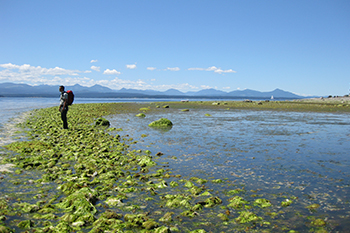
Coast Salish First Nations, whose ancestral territories criss-cross the southern Gulf Islands, have managed their lands and resources for thousands of years. Evidence of their hard work is found across the Gulf Islands in the form of canoe runs, camas meadows and sea gardens.
Sea gardens
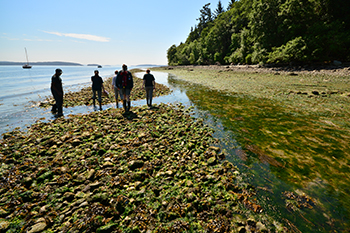
Coast Salish peoples care for their beaches using traditional practices such as removing kelp and sea lettuce. They turn their beaches with specialized tools to loosen the sand, allowing more room for creatures to grow.
At some locations, Coast Salish peoples modify beaches by building rock walls near the lowest tide mark. These walls trap sand and sediment, creating a terrace on the landward side. Such modified beaches are known to some as “sea gardens.”
Knowledge holders and scientists explain that sea gardens can be highly productive, supporting four times as many butter clams and twice as many littleneck clams compared to unmodified beaches (Groesbeck et al, 2014).
Sea Gardens – Learning Together
Transcript
May Sam, a Wsánec’ Elder, stands in a field singing a traditional song. Volunteers and Salish people stand quietly listening to her song
[Jim Elliot is sitting on a log in front of the coastline.]
Well, when we talk about clam harvesting,
it’s been important to our people for thousands of years and I really believe it is one of the unique attractions to the coastline for Salish people. All year round you have a very valuable source of protein right at your front door.
[Close shot of May Sam in front of the coastline.]
Years ago, 1960's, my mother in law used to dig the clams, and while we were digging she was boiling the clams on the beach and getting that all prepared. She had a great big tub on the fire, open fire, and cooking while we were digging and digging. It was a long day’s work, two day’s work with the ironwood and the cedar root and stepping on it. That was the fun part, was having to step on the clams, and not knowing if we were heavy enough to press it.
[Far shot of volunteers and Salish people standing by the coast.]
[A man places a log on a campfire. A pot of clams boils atop the fire.]
[A man drains the water from the clam pot using a cloth.]
[May Sam lays a white cloth on the ground and places the boiled clams on the cloth.]
[The clams are skewered on a stick, placed between two evergreen bows and then stepped on by volunteers.]
[Hul’qumi’num Camp leader]
A lot of our elders aren’t going to be around for too long to teach us. I find it actually very important to bring the young youth and get them involved because a lot of our tradition has been lost and it’s actually all new to me as well.
[Close shot of a Hul’qumi’num Camp leader in front of the coastline.]
[Shots of Elders interacting with volunteers and Salish People.]
[Shots of youth interacting with nature.]
[Close shot of Philomena, a Hul’qumi’num Elder, in a tranquil forest setting.]
This is something that was a staple for our people for many, many, many moons. Life in the ocean was our means. We were able to sustain ourselves by the ocean. We were able to also utilize all of the things in the forest. With all of these things we have, we’ve got the stories, and all of the stories that we’ve had, had morals.
[A panoramic view of a calm, serene ocean. Medium shot of a Parks Canada employee helping volunteers dig for clams. Jared Williams beats a traditional drum.]
Nathan Cardinal stands in front of the ocean.
Through this projects we’re able to bring First Nations youth, , bring elders to sites of traditonal importance and historical importance to them and reinvigorate that ecological and cultural landscape. So for Parks, you know it really is about partnership, about knowledge and combining ecology and culture, which are two prominent mandates of the Parks Canada Agency
[Pan across a tranquil coastal view. Shots of volunteers working.
[Medium shot of Jared Williams standing in front of the ocean.]
After all of these generations of denying that we had agriculture and that we had this sustainability, we’ve actually started to meet and to have the evidence that we had all these systems in place pre-contact. To have a large agency like Parks Canada designing a program bringing western science and traditional science together to discuss that, it’s just, it’s the beginning of a giant unifying discussion that should have happened hundreds of years ago and I’m really happy that it’s actually happening and that I’m able to be a part of it.
[Shots of volunteers building a fire, gathering clams and interacting with one another. Jared Williams beats a traditional drum and sings a Salish melody.]
[Title: Parks Canada would like to thank: May Sam, Skip Sam, Philomena Williams, Jim Elliott, Jared Williams, the WSANEC and Hul'q'umi'num Nations, Cowichan Tribes Youth Centre, Northwest Indian College, NSERC (French is CRSNG), Royal Roads University, and the WSANEC School Board.]
Parks Canada logo.
© Her Majesty the Queen in Right of Canada, represented by Parks Canada, 2015.
National Conservation Plan
Canada wordmark.
Caring for beaches
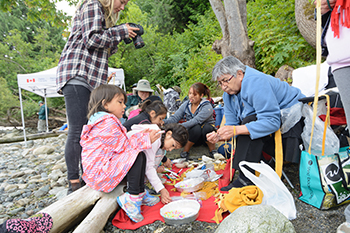
A tended sea garden has many purposes; it serves as a pantry, teeming with delicious food. It is also a classroom, where Elders share knowledge and work alongside youth. Together, the entire community cares for the sea garden to keep it healthy.
Sea garden restoration
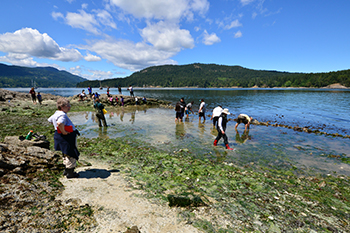
In 2014, the Gulf Islands National Park Reserve, in partnership with members of the Cowichan Nation Alliance and WSÁNEĆ Nations, began restoring two sea gardens, which haven’t been tended for hundreds of years.
So far, the clams on the beaches have been monitored and restoration has begun. This work is guided by Coast Salish knowledge holders, and complemented by modern scientific methods. Some days, we move big boulders while listening to stories. On others, we use scales and gauges to assess the health of the intertidal ecosystem.
Give thanks
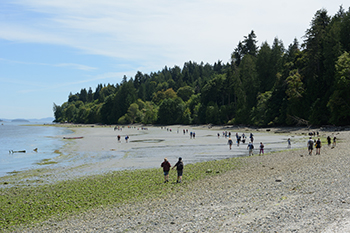
A special thanks to the Cowichan Valley School District (SD. 79) and the WSÁNEĆ School Board who have made sharing knowledge with Coast Salish youth a top priority.
Huy ch q'a, HÍSWḴE and thank you.
Learn more: Bivalve Monitoring - A Photo Story
- Date modified :